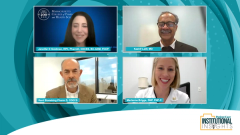
Deciphering Diabetes Onset: The Crucial Role of B Cells and Diagnosis Considerations
Kashif Latif, MD defines diabetes, shedding light on the pivotal role of B cells. He introduces the concept of diabetes stages and emphasizes the critical importance of early intervention to prevent complications.
Episodes in this series

The following transcript has been lightly edited for clarity and style.
Dr. Jennifer Goldman: And so why do we want to intervene? Early intervention is certainly crucial. And why would that be?
Dr. Kashif Latif: So I think I want to take it maybe one or two steps back and talk about diabetes as a whole. Diabetes is a progression of beta cell function decline, be it from overwork and overburden in type 2 people, or with autoimmune destruction in type 1. So we diagnose diabetes with an A1C of 6.5 with a two-hour GTT, where the two-hour glucose level is over 200 or a random blood glucose level, which is over 200. But we do need to emphasize the progression of the disease process itself. So now we are at a point where type 1 diabetes is diagnosed as with the presence of two autoantibodies. So if you have two positive autoantibodies, by definition, you have type 1 diabetes, which is stage 1 with normal blood glucose. Now, if the blood glucose starts to get erratic or up or down, and it is in the prediabetes stage, then you call it dysglycemia, and that is stage 2 type 1 diabetes. And once you get to the stage where you have florid type 1 diabetes, where the blood glucose is extremely high and you meet all criteria for diagnosis of diabetes, that is called stage 3.
So I think it is really important for us to kind of pull back just a little bit, go to the drawing boards, and say, "How do we define this glucose or dysglycemic progression from normal glycemia to dysglycemia, and then all the way to hyperglycemia with diabetes? And then obviously, I think that I'll be preaching to the choir, everybody in the audience understands that once you have diabetes, be it type 1 or type 2, the two big categories that we divide the complications is microvascular and macrovascular. And microvascular is simple. It's just neuropathy, nephropathy as well as peripheral neuropathy. And so with macrovascular, you have your cardiovascular disease, you have CVAs. So, again, we all understand those two buckets. And so I think the goal, as we have seen in multiple studies in ED as well as a lot of studies, that if we can slow down this progression down this path from prediabetes to diabetes, or even start at resistance or dysglycemia and all the way down, we can actually make a huge difference, not only in patients' lives as well as how they function at home, as well as chronically for the community, it makes a huge difference. So I think, first and foremost, I may be taking the long road in saying this, but I want to set the stage up for us to realize that the glycemic pathway is a progressive pathway. It's dysglycemic. And so, be it type 2. And now we know a whole lot more about type 1.
Dr. Jennifer Goldman: Well, we'll briefly touch upon those stages again shortly, but let's do an audience poll.
So, for the audience, who do you believe constitutes primary populations at increased risk for developing type 1 diabetes? And you can select all that apply. And once we have those answers, we'll push it forward and see what we kind of came up with. We have any results? Excellent. So we have 77% voted for children and adolescents and 100% people with family history and people with autoimmune conditions. Let's take a look and kind of talk about that a little bit. And we know that socioeconomically there's a burden and emotionally there's a burden. But what do you think about that emotional toll with people with type 1 diabetes? Because it's not just the patient, is it?
Dr. Kent Stoneking: Not at all.
Dr. Jennifer Goldman: So we're talking big picture. It's the family. It's the teachers. It's the community. And so, by reaching people and delaying this, we can certainly make a big impact.
Newsletter
Enhance your clinical practice with the Patient Care newsletter, offering the latest evidence-based guidelines, diagnostic insights, and treatment strategies for primary care physicians.




























































































































































































































































































































